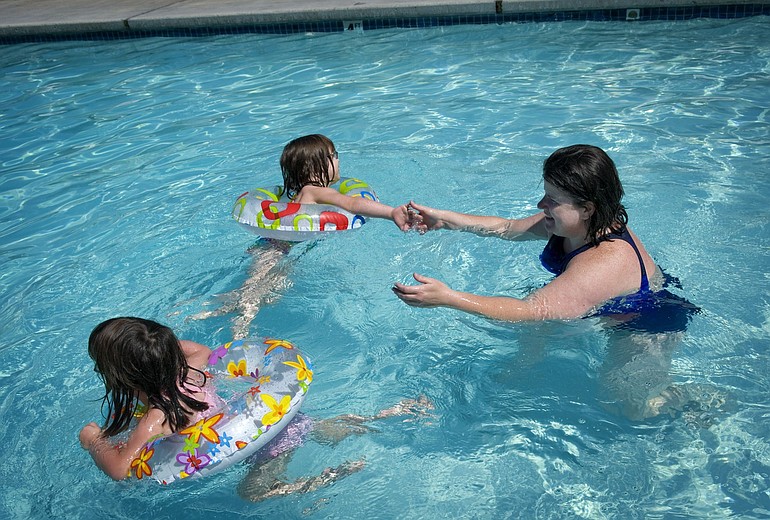Parents across Clark County may be buying toys with lead levels that would have been illegal here two years ago.
And only when those toys are packaged for sale in California will they even find out the products contain lead, which has been shown to cause developmental delays in kids.
Vancouver mother Laurie Hughes was stunned recently, for example, to read the fine print on pool toys she had purchased at a local Dollar Tree store. Her daughters, Bailey Bartlemay, 4, and Maura Bartlemay, 3, had played with the vinyl, 24-inch “Splash-N-Swim” swim rings during a family outing to the pool at their apartment complex. Afterward, Hughes discovered the warning printed on the toy package:
“This product contains chemicals, including lead; known to the state of California to cause cancer and birth defects or other reproductive harm. Wash hands after handling.”
“I just about fell on the floor,” Hughes said. “Both of my kids had it in their mouth, for crying out loud.”
She returned the toys to the Dollar Tree store at 305 S.E. Chkalov Drive. She was told by store personnel that the warning was “only relevant in the state of California,” which requires the label, Hughes said.
Though Dollar Tree’s labels are alarming, they could be seen as a favor to parents. Countless toys sold in Washington and all other states besides California have enough lead to cause harm, but don’t carry any warning.
No safe level
Jim White, a toxicologist from the Washington state Department of Health, said Hughes acted wisely.
“The consensus at the moment is there’s really no safe level of exposure for kids,” White said. Even trace amounts can cause harm, especially in young children, he said.
Yet there is little that parents can do. The Dollar Tree toys contained a low enough level that lead didn’t register when they were tested using Consumer Reports’ top-rated lead-testing kit, the Homax-brand Household Lead Check.
Moreover, products not sold in California may not even disclose the chemical. Nationally, toys are allowed to have lead levels of up to 300 parts per million. But California is the only state that requires a written warning on the packaging when products contain lead, said Jim Finefrock, a spokesman for California’s attorney general.
That means that even when toys sold in the other 49 states contain enough lead to worry toxicologists, parents may never know.
The Consumer Product Safety Improvement Act of 2008 is supposed to offer some protections. But it doesn’t always work.
Toy sellers must have access to lead testing results for every toy, said Kim Dulic, a spokeswoman for the U.S. Product Safety Commission, which regulates compliance nationwide.
Companies that don’t comply face a variety of consequences, including civil penalties, Dulic said.
Dollar Tree spokeswoman Shelly Davis said the Virginia-based company meets national testing requirements with all toys sold by its 3,900 discount stores.
The swim rings bought by Hughes were made in China by Dollar Tree’s exclusive manufacturer, Greenbrier International Inc. The toys would have been tested at the overseas plant, Davis said.
Dollar Tree officials did not respond to a question asking exactly how much lead is in the product. Over-the-counter test kits are not specific enough to give an exact reading.
“It is our policy to test and it is our policy to meet federal standards,” Davis said.
Mary Sisson, co-owner of Kazoodles, which operates two independent children’s toy stores in Vancouver, said her stores keep on file the test results of each of the more than 5,000 toy items the store carries.
“If the toy passed the federal standards, the store should be able to produce a document with the testing results,” Sisson said.
Kazoodles does carry some toys that contain lead, but Sisson said the levels are very low, and that she can provide documentation backing this up. For example, a toy might contain 1.75 parts lead per million — less than 1 percent of the allowable level.
“You can’t, in a natural state, reach zero,” Sisson said. “All of the toys in our store comply with the law.”
Changing rules
Federal lead restrictions are growing gradually more strict, said Patty Davis, a spokeswoman for the U.S. Consumer Products Safety Commission. But at the moment, toys sold in this state can contain more lead than Washington once allowed. Before the federal law passed, Washington restricted children’s toys to lead levels of no more than 90 parts per million. The federal law pre-empted that requirement.
At first, the Consumer Product Safety Improvement Act allowed lead quantities of 600 parts per million in products intended for children age 12 and younger. After six months, the maximum lead level for toys dropped to 300 parts per million.
In August 2011, the allowable level will drop to 100 parts per million.
“These are minute levels,” Patty Davis said.
These tightening restrictions reflect a growing sense of public alarm about children and lead exposure, said Curt Hart, a spokesman for the Washington state Department of Ecology, which previously regulated lead levels in products sold in the state.
Today’s allowable lead levels are cause for alarm for parents who want to protect their children, Hart said.
“As a parent, I would err on the side of caution,” he said.
That’s what Hughes plans to do in the future.
“I can’t trust that everything on the shelves is safe anymore,” she said.



